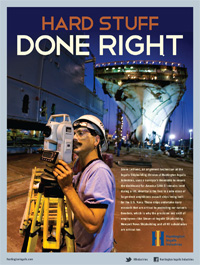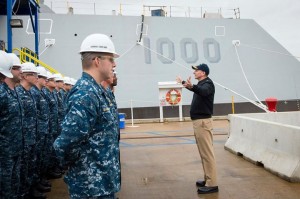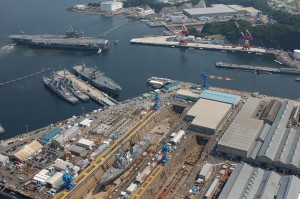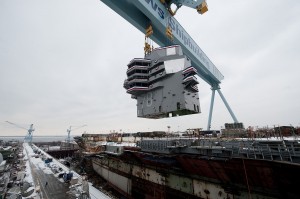 A few decades and a couple defense cuts ago, some wise ‘ole marketer floated the concept that America’s national security depended upon the guaranteed health of the (then) six “large” U.S. naval shipyards: Northrop Grumman’s Avondale, Ingalls and Newport News yards and General Dynamics’ Bath Ironworks, NASSCO and Electric Boat acquisitions.
A few decades and a couple defense cuts ago, some wise ‘ole marketer floated the concept that America’s national security depended upon the guaranteed health of the (then) six “large” U.S. naval shipyards: Northrop Grumman’s Avondale, Ingalls and Newport News yards and General Dynamics’ Bath Ironworks, NASSCO and Electric Boat acquisitions.
This idea of a “Grand Naval Shipbuilding Duopoly” was so appealing to Congress and the Navy, it stuck around for almost twenty years. Some shipbuilders even started believing their own hype, doing an enormous disservice to the Navy, the American shipbuilding industry and, ultimately, the nation.
Over the past few years, that toxic idea–that the big naval shipyards were irreplaceable–and therefore un-touchable–had, more or less, receded. But now, as we peer down the barrel of the Terrible ’20s and eye a catastrophically underfunded naval shipbuilding plan, the old meme is coming back!
Sigh. Things had changed. With the retirement of grand old pork-barrel shipbuilder Senator Trent Lott (R-Huntington Ingalls) in late 2007, the 2010 defeat of Gene Taylor (D-Huntington Ingalls), and the late 2010 closing of the “Big Shipbuilder’s” lobbying shop, I had thought that the “Big, Irreplaceable National Asset” meme had died and was pretty much forgotten.
Which was great.
I’m biased, of course. As a fan of small, hungry shipyards, I’ve been raging about the “Irreplaceable Shipbuilder” meme in various forums since 2007, helping to push the incompetent and wasteful American Shipbuilding Association–the “Big Six” lobbying house–out of business. A few years ago, big shipbuilders even rejoined the Shipbuilder’s Council of America, an industry association whose advocacy for the “little guys” helped cause the “Big Six” to storm out years ago. Things were looking good for American Naval Shipbuilding–the large guys had business, and a host of little yards were circling around, pouncing upon every opportunity the big yards let slip through their fingers.
 But today, the “Big Five Shipbuilder” meme is back with a vengeance.
But today, the “Big Five Shipbuilder” meme is back with a vengeance.
Read the transcript from the Chief of Naval Operations Admiral Jonathan Greenert’s November 4 “fireside” chat at Brookings:
But to your point, I’d say — I worry about the shipbuilding industrial base….But more importantly, if we lose a builder here and there, and they’re some likelihood we lose one or two builders — and we only have five — then we lose that competition I mentioned earlier which gets you much more effective and efficient shipbuilding base, and it gets you the situation where if you need to reconstitute your ship account, if you will, you can put money in, but you only have so many builders…
When pressed to name the five, CNO Greenert responded:
Sure. It’d be Bath (ph) up in the northwest in Maine. Electric Boat in Connecticut. Down in the Newport News area, you have Huntington. And then you have Ingalls (ph) down in Gulfport, Mississippi. And you have NASCO (ph) out on the West Coast in the San Diego arena. So, those are the big ones. There are other shipbuilders, but those are the big ones that provide, if you will, our capital ships. The littoral combat shipbuilders are up in the northwest, in the Wisconsin area and down in the Gulf, in Mobile, Alabama.
Emphasis mine. There’s just so much wrong here.
First off, we all need to acknowledge the “Big Five” concept is not real. It is a lobbyist/marketing confection, based upon a number of mistaken perceptions. Here are a few:
The “Big Five” aren’t the biggest shipyards: I worked for a shipyard down in Alabama that employs more folks than NASSCO does (shocking, I know, I know…). A year ago, NASSCO employed about 3,100, while Austal employed hundreds more. From UT San Diego:
In 1970s, the company’s workforce peaked at 7,800 employees. But employment started to erode, falling to 5,200 in 1985 and 3,800 in 1990. The figure jumped back to 5,200 in 1995, then fell to 2,900 in 2000. NASSCO then received a contract to build 14 auxiliary ships for the Navy, sending employment to 4,100, a figure that began to fall in 2010. It now stands at about 3,100. But it should reach about 3,900 as the tanker program ramps up.
Size has nothing to do with the “Big Five”.
The “Big Five” don’t all make capital ships: You heard it from Admiral Greenert: “those are the big ones that provide, if you will, our capital ships.” Well. That might be the case for most of those yards, but not all. I don’t mean to pick on NASSCO, but auxiliaries are not capital ships. (They’re important, and becoming more so, but…they’re still not capital ships) NASSCO has built T-AFS, LSTs, T-AORs, ADs, T-ARCs, T-AKRs, T-AKs, T-AHs, T-AKEs….nary a capital ship among the lot.
The Big Five, in general, make big, large tonnage ships….but they’d certainly love to make small ones like, say, the LCS(Next) frigate, or the Offshore Patrol Cutter (which four of the five bid on). And I’d wager that the Big Five simply hate the idea of smaller yards cutting their teeth on small ship projects–and then using that experience to become a competitive threat, bidding for “larger ship” projects.
 The “Big Five” aren’t all “Effective and Efficient”: Again, you heard it from Admiral Greenert: The idea is that if America looses one of the five, America will “lose that competition…which gets you much more effective and efficient shipbuilding base…” Well, uh, no. Nope. If this “Five Shipyards” thing was such a panacea, why was Newport News Shipbuilding given a dead last, third-tier, dog-of-defense ranking in the new Superior Supplier Incentive Program? (Hint to the CNO: it’s not because Newport News is efficient or effective!)
The “Big Five” aren’t all “Effective and Efficient”: Again, you heard it from Admiral Greenert: The idea is that if America looses one of the five, America will “lose that competition…which gets you much more effective and efficient shipbuilding base…” Well, uh, no. Nope. If this “Five Shipyards” thing was such a panacea, why was Newport News Shipbuilding given a dead last, third-tier, dog-of-defense ranking in the new Superior Supplier Incentive Program? (Hint to the CNO: it’s not because Newport News is efficient or effective!)
By eliminating the threat of better, more efficient competitors, the “Big Five” idea is nothing more than an effort to promote…uh…a tacit duopoly. And that’s, well…not right.
Any “Big Five” Member Can Be Eliminated or Replaced: For all the gnashing of teeth, the Navy survived the closure of Avondale (that godawful pit of poor performance) and came out smelling like a rose. The LPD-17 program is back on track, and even Huntington Ingall’s overall performance as a company has gotten a lot better without the Avondale drain.
Imagine how much healthier the LPD-17 Program and Huntington Ingalls would be right now had we all dispensed with the “Six Yards” baloney and shuttered Avondale long ago?
Look, American shipbuilding should be an object lesson in good old U.S. Capitalism, but the moment the customer (or Congress) eliminates the threat of going “somewhere else” there’s no incentive to get better. I mean, if the past twenty years wasn’t enough to conclusively demonstrate to the Navy that their friendly naval shipbuilding duopoly failed to deliver effective, efficient shipbuilding…I don’t know what to say. But, please…instead of propping up non-performers (even if they’re mission-critical non-performers) let’s try to open the field a bit, instead.
There are a handful of hungry smaller concerns (BAE Southeast Shipyards, Bollinger, Eastern, Aker Philadelphia, Foss Maritime, and VT Halter…to name a few) who deserve a chance to pick off a poor performer. And if allowed, they will.
And the Navy will benefit.
At the end of the day, folks who promote the Big Five are all about constraining competition—leaving the rest of America’s innovative shipbuilders with nothing but tarry or briny leftovers from either Huntington Ingalls or General Dynamics.
And if the rest of America’s shipyards knew what was good for ’em, they’d be hollering bloody murder at this resurgence of the “Big Five” meme.
The Navy has a job to do. Here are a few suggestions:
Acknowledge that a Diverse, Healthy Shipbuilding Industry Is Good For The Navy: It’s natural to try and protect old, established systems in times of budget crisis. But America must do more than just try to protect the “Five Shipbuilder” status quo–ultimately, the Navy and nation derives greater benefit (flexibility, supplier competition, workforce sustainment, R&D, etc.) from a healthy, competitive American shipbuilding industrial base.
The record accumulated over the past twenty years should be sufficient to demonstrate that a shipbuilding base artificially tied to supporting a General Dynamics/Huntington Ingalls Industries duopoly devolves to become a fragile, inefficient shadow of what it should be.
Assure Good Performers Of More Business: Worry about protecting performers and generating better performers. As I have written before, General Dynamics Shipbuilding performs–and if you don’t want to take my word for it, then look at the Pentagon’s Superior Supplier Incentive Program. General Dynamics Marine Systems is on top.
So…if solid performers (like, say, the Virginia Class SSN program) are given some goodies (better pricing, an opportunity to make better margins or more hulls or something like that), then that’s great (and if the goodies go away quick, at the first sign of poor performance, even better). But…if there’s no pressure for the chronically second-place Huntington Ingalls to perform, and the Navy is OK about letting HII kinda cruise along as America’s “second-tier first-tier” shipyard, enjoying their “irreplaceable” status as a CVN-builder, then we’re not doing the Navy any favors.
So let’s inject some competition there, at the low-end, to force competition and to keep the under-performing member of the duopoly from becoming too cozy.
 Incentivize Capitalism: Give some of these emergent “not-so-large” commercial yards a chance at Government business. And if we’re going to give the big guys nice, stable block buys (like, say the Virginia Class SSN), then give the little guys–the poor fellas who, oh, took risks to expand and take on government business–some added support and contractual stability as well. (It’s only fair!)
Incentivize Capitalism: Give some of these emergent “not-so-large” commercial yards a chance at Government business. And if we’re going to give the big guys nice, stable block buys (like, say the Virginia Class SSN), then give the little guys–the poor fellas who, oh, took risks to expand and take on government business–some added support and contractual stability as well. (It’s only fair!)
If it’s all about competition, then the Navy needs to entice more shipbuilders into bidding for government business rather than, well, chasing them away.
Now….it’s perfectly OK for the Navy to celebrate the big yards. They’re all industrial showpieces that merit a good helping of national pride. But let’s be truthful about it. General Dynamics’ Fred Harris is a shipbuilding wizard, who made NASSCO one of the few yards capable of juggling both government and commercial business (a feat that is almost impossible nowadays). We should expect great things. Huntington Ingalls is getting leaner, and they have a monopoly on surface ship nuclear power–a key bit of industrial base that, in this day of energy-based weaponry, probably would benefit from additional government R&D into new reactor types and some Green Fleet support.
But they sure ain’t perfect. Giving these big guys a completely free pass is unfair.
I’m as scared of the “Terrible Twenties” as anybody else. But, over the long-term, I’m bullish about American naval shipbuilding. As China develops her Navy, and as Chinese ships start to nose about the Gulf of Mexico, the West Coast and the Arctic, the American apatite for naval craft is going to increase.
In particular, it’ll be a small ship market. Naval tech in itself is getting smaller, and that’s going to change the industry (and I’ll talk about how the big guys have done their part to slow small craft development in a later post). But….if trends hold, U.S. demand for Coastal Defense craft, Exclusive Economic Zone patrol ships, ASW Coastal Subs and logistical support ships to support the small craft will grow. And, if prior experience is any example, demand for these ships will grow quickly, in the space of a few years (almost overnight in shipbuilding terms). The only way that America is going to be able to support such demand is to have a healthy shipbuilding industrial base that extends beyond the “Big Five.” And, to me, that means taking some time to tend the hungry “little guys” and supporting those with dreams of bigger things.
Starving the entire U.S. shipbuilding sector to support a cozy duopoly isn’t the way to go. It’s bad for the Navy and dangerous for the nation. So, please, let this “five shipyards” meme die and replace it with something more accurate, more pro-shipbuilding and, well, more, uh, American.




{ 8 comments… read them below or add one }
I will buy your argument, and carry it one or two steps further.
I submit to you, based on your own research and writings, that US Naval Ship Procurement is a disaster. Instead of being the answer to a national security concern, it is the source of one. Round up the usual suspects.
In the past, you have written about proposals for ships that would do everything – or nearly everything: about plans that were so monumental and ambitious, put forward by builders that were so hungry for business, that when followed through with, produced perverse results; that is, produced vessels that could not be done without, and which required defense in every sense of the word – ships, and ship appropriation line items that in the final analysis represented not a national security asset, but a liability. I forget the exact term you used, but it was one that conveyed the sense that once committed to, it created its own raison d’etre.
We also know, as has been observed by others commenting here, that there is gross political interference with the process. And, for instance, we also know that sometimes, a large and influential defense contract will simply sell a member of Congress, or one of his or her staffers, on an idea that has the effect of reserving to it a line item in a defense appropriation bill, while only having empty cupboards to sell from.
The “Big Five” as you refer to them, are not a monopoly. But due to the ever-increasing complexity and scale of the operations they undertake, the ever-increasing expense of their products, their ever-growing yards, their ever-growing influence, and the ever-increasing penalties that must accrue to those who would compete with them for business, due to a market that is shrinking in proportion to all of the above, they might as well be. Amongst themselves, they exercise monopoly control. They are, instead, an oligopoly. ( What’s in a name ?)
Is this good ? Well, just look at the results. Someone’s head should role.
That, of course, would not necessarily fix much, for this is a many-headed monster. And so, I feel compelled to offer a better solution. Here is one:
I am from New Hampshire. And I just happen to think that the best naval ship yard in America happens to be owned by the US Navy. It is the Portsmouth Naval Shipyard.
Perhaps the penalty for failure for a shipbuilder in a America “to big to fail”, which is found guilty of placing the future of this country at risk, should be that its assets are condemned and handed over to the US Navy. This business is just too big and too important to be entrusted to private contractors. Let there be another government owned yard.
In closing, I offer one note on matters of definition. A capital ship is not an oiler, or a tanker or even an ordinary ship of the line. It is one of a kind, or of a class, upon which the fortunes, and prestige, and successful strategies of a naval power depend. It is the King or Queen of a certain chessboard.
Well, so what ? This; I should hope it would not be one of those referred to above as representing more of a liability than an asset: a steel coffin or a bottomless money pit.
In my estimation the soon to be USS Zumwalt promises to be a capital ship. That is as important as it is unusual. Indeed, it is precedent setting, since never before has a destroyer been considered a capital ship.
The Zumwalt is clearly meant to be revolutionary. Who do we go see about the fact that it has proven to be a fiscal failure ?
R/s, TPH
I’m of the opinion that shipyard politics is driven by congressional demands more than anything else. Admiral Greenert must stroke the yards where congressional seniority and majority have a stake.
It’s worth noting that a GOP Senate takeover will shake things up. They now get the gavels. Shipyards along the GOP dominated Gulf Coast will likely gain, while sub building in New England may drop in priority. West Coast senators, all eight of them Democrats including Hawaii, are suddenly out of power, losing multiple committee chairmanships, and now must labor to promote the Pacific pivot. It’ll take a year or two to see this all evolve.
A visible example of such a shift can be seen with the Boeing aerial tanker contract. Airbus had initially won the competition, but Senator Patty Murray of Washington, the Budget Committe chair, protested and strong armed DOD into reopening and reversing the decision. Much of the Airbus assembly would have occurred in southern states, but Murray had a gavel and her party had the majority, and so those tankers will be built in Everett, WA. Healthy competition is sometimes no match against political headwinds.
Shame about Avondale; our fleet of unrep tankers was built there 85-95, they have turned out to be fine hardworking vessels inspite of the political pressures imposed on what and where much of the engines and machinery came from. My personal opinion is that they are a better executed product than the T-AKE’s from NASSCO CA.
Yeah, if the US had recapitalized her logistics and support fleets (all those old tenders and fleet train support, Avondale would have been a profitable place, and owner of a good niche business.
T-AKE’s entry into service was a bit of a mess, too, right? It’ll be interesting to see how they stand up after thirty years at sea….
Critical to breaking the stranglehold that big yards have is buying smaller, less sophisticated ships, for less money each. As long as the Navy considers Arleigh Burke DDGs “escorts” and everything smaller to be beneath their dignity, it will take large, sophisticated and rich yards to build Navy warships.
Part of this is inescapable; a yard with the capabilities to build CVNs will only remain so large and capable if steady business is assured.
Large surface combatants, destroyers through amphibs, have more flexibility because they are not nuclear-powered, but still are limited to yards which can rely on steady contracts.
Until we start buying truly small combatants (single-role corvettes of 4000t and smaller), the Coast Guard will be the only government agency with business for the small yards.
True enough. But…just for giggles, what would be the business implications for Newport News if HII suddenly came out with a new, lower-maintenance, few-personnel requirements nuclear power plant for use by big surface combatants and amphibs? It’d probably cost too much, but…I’d sure love to tinker with the numbers on ’em…
And…I do think we’re seeing the Navy give quite a lot of business to the gliders and other UUV/USV builders (dear god, if I was in the American unmanned target business, I’d be making a mint!!). Yeah, they’re boats, but…it suggests a trend…
I take exception with some points made. I know beating up on big companies these days is pretty easy. 1. Your disrespect of ammo and support ships, saying they aren’t ‘capital’ so it invalidates the CNOs point, is not deserved. Last time I checked, the US Navy would have an extremely hard time operating without these ships, and these ships are also crucial to the other services for their operations. Derisively saying they aren’t ‘captial’ is actually pretty misleading, as those would likely be the first targets of any adversary.
2. Your apparent dream of building the Navy’s ships through a pethora of smaller yards falls on its face when you take building nuclear warships, whether CVNs or subs, into account. A ‘small’ yard would not have sufficient capital investment or skillsets to accomplish these build projects. 3. Finally, I am not sure where you are getting your vision of the future, but as far as I know the Navy has no plans to scrap its current big-ship strategies and go to a smaller corvetteand coastal based lineup, which you are somehow predicting. Yes, the Navy is looking to replace the FFGs, but most likely with upsized/upsticked versions of the LCSs, not ‘small ships’ by anyone’s definition.
Bottom line, it sounds like you have issues with the big shipyards for whatever reason, to the point that you are somehow predicting an unlikely future navy that would of course benefit by this galazy of smaller yards.
Hi Dave. Welcome to the blog, and I encourage you to look around the blog a bit. If you do, please take to time to read my Proceedings piece, “Running on Empty”- (there’s a link to it on the right-hand column)-one of the few bits of pro T-AO(X) advocacy available. Or try this link:
http://nextnavy.com/surface-navy-association-stop-ignoring-the-logistics-fleet/
Or this one:
http://nextnavy.com/seafighters-will-never-operate-in-a-logistics-free-world/
I wholeheartedly agree that logistic ships would be the first target of an adversary, and have suggested as much in writings regarding the Chinese ship-killing ballistic missiles. So. I respect the logistics fleet an enormous amount.
That said, the issue I am addressing is accuracy and precision. Logistic ships are very rarely called to lead fleets. So, sorry to disappoint you, but, while they are important, logistic ships are not capital ships.
2. I don’t have a dream of making a navy from smaller yards. I have a dream of smaller, hungrier, more efficient yards getting business, and growing to become big yards–possibly even yards that could build a CVN! or other nuclear combatant. It’s about the ebb and flow of capitalism–and I think it’s right to give the little guys a chance to compete and, possibly, via competition, dethrone a non-performer.
3. As I said, wait till China starts sailing ships off the West Coast. The face of the Navy can change pretty darn fast when external conditions change!
Bottom line, I have problems with inaccurate marketing slogans becoming accepted as gospel truth. I have problems with supporting poor performing industries and protecting those industries from competition. Size of the yard doesn’t matter to me. What matters is that they build a good ship, on time and on budget. And if competition can help me get a good ship on time and on budget, then I’m all for it.
Cheers, and happy reading.